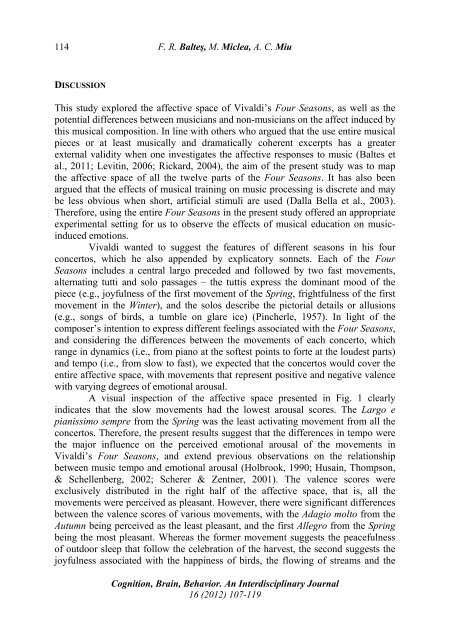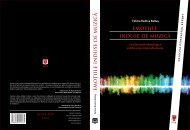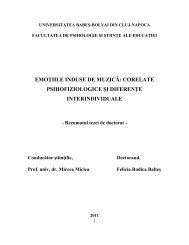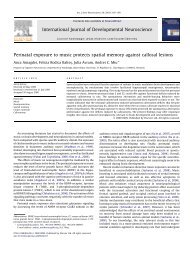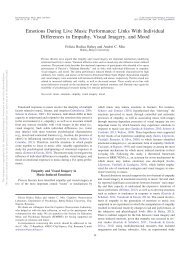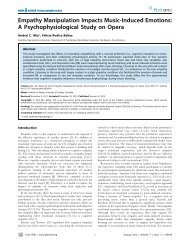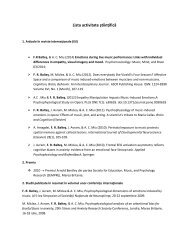o_19k6fnuqsqg41mt7rqp1c8pkueo.pdf
Create successful ePaper yourself
Turn your PDF publications into a flip-book with our unique Google optimized e-Paper software.
114<br />
F. R. Balteş, M. Miclea, A. C. Miu<br />
DISCUSSION<br />
This study explored the affective space of Vivaldi’s Four Seasons, as well as the<br />
potential differences between musicians and non-musicians on the affect induced by<br />
this musical composition. In line with others who argued that the use entire musical<br />
pieces or at least musically and dramatically coherent excerpts has a greater<br />
external validity when one investigates the affective responses to music (Baltes et<br />
al., 2011; Levitin, 2006; Rickard, 2004), the aim of the present study was to map<br />
the affective space of all the twelve parts of the Four Seasons. It has also been<br />
argued that the effects of musical training on music processing is discrete and may<br />
be less obvious when short, artificial stimuli are used (Dalla Bella et al., 2003).<br />
Therefore, using the entire Four Seasons in the present study offered an appropriate<br />
experimental setting for us to observe the effects of musical education on musicinduced<br />
emotions.<br />
Vivaldi wanted to suggest the features of different seasons in his four<br />
concertos, which he also appended by explicatory sonnets. Each of the Four<br />
Seasons includes a central largo preceded and followed by two fast movements,<br />
alternating tutti and solo passages – the tuttis express the dominant mood of the<br />
piece (e.g., joyfulness of the first movement of the Spring, frightfulness of the first<br />
movement in the Winter), and the solos describe the pictorial details or allusions<br />
(e.g., songs of birds, a tumble on glare ice) (Pincherle, 1957). In light of the<br />
composer’s intention to express different feelings associated with the Four Seasons,<br />
and considering the differences between the movements of each concerto, which<br />
range in dynamics (i.e., from piano at the softest points to forte at the loudest parts)<br />
and tempo (i.e., from slow to fast), we expected that the concertos would cover the<br />
entire affective space, with movements that represent positive and negative valence<br />
with varying degrees of emotional arousal.<br />
A visual inspection of the affective space presented in Fig. 1 clearly<br />
indicates that the slow movements had the lowest arousal scores. The Largo e<br />
pianissimo sempre from the Spring was the least activating movement from all the<br />
concertos. Therefore, the present results suggest that the differences in tempo were<br />
the major influence on the perceived emotional arousal of the movements in<br />
Vivaldi’s Four Seasons, and extend previous observations on the relationship<br />
between music tempo and emotional arousal (Holbrook, 1990; Husain, Thompson,<br />
& Schellenberg, 2002; Scherer & Zentner, 2001). The valence scores were<br />
exclusively distributed in the right half of the affective space, that is, all the<br />
movements were perceived as pleasant. However, there were significant differences<br />
between the valence scores of various movements, with the Adagio molto from the<br />
Autumn being perceived as the least pleasant, and the first Allegro from the Spring<br />
being the most pleasant. Whereas the former movement suggests the peacefulness<br />
of outdoor sleep that follow the celebration of the harvest, the second suggests the<br />
joyfulness associated with the happiness of birds, the flowing of streams and the<br />
Cognition, Brain, Behavior. An Interdisciplinary Journal<br />
16 (2012) 107-119


